The document provides protocols and guidelines for the Department of Obstetrics including definitions, classifications, investigations, and management guidelines for various obstetric conditions. It covers protocols for pre-eclampsia and eclampsia, liver diseases in pregnancy, deep venous thrombosis in pregnancy, preterm labour, preterm PROM, breech presentation, APH, induction of labour, normal labour and delivery, PPH, umbilical cord prolapse, Rh prophylaxis, and GDM. The department aims to provide high quality, empathetic and research-based care through comprehensive training and by reviewing and creating protocols according to population needs.
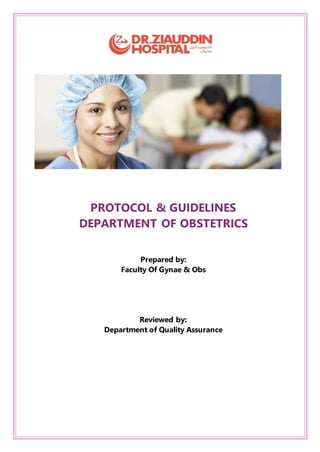

























![27 Procedure/ Protocol/SOP’s Obstetrics & Gynecology
12. Sangkomkamhang Ussanee S, Lumbiganon Pisake, Laopaiboon Malinee. Hepatitis B vaccination during
pregnancy for preventing infant infection. Cochrane Database of Systematic Reviews: Protocols 2009
Issue 3 John Wiley & Sons, Ltd Chichester, UK DOI: 10.1002/14651858.CD007879
13. Royal College of Obstetrics and Gynecologists. Obstetric Cholestasis Green-top Guideline No. 43 April
2011
14. Obstetrics and Gynaecology; An Evidence – Based Text for MRCOG(2nd
Edition 2010)
15. Rajasri AG, Srestha R, Mitchell J. Acutefatty liver of pregnancy (AFLP)--an overview. J Obstet Gynaecol.
2007 Apr. 27(3):237-4. [Medline].
16. Ahmed KT, Almashhrawi AA, Rahman RN, Hammoud GM, Ibdah JA. Liver diseases in pregnancy: diseases
unique to pregnancy. World J Gastroenterol. 2013 Nov 21. 19(43):7639-46. [Medline]. [Full Text].
17. Bellig LL. Maternal acute fatty liver of pregnancy and the associated risk for long-chain 3-hydroxyacyl-
coenzyme a dehydrogsenase (LCHAD) deficiency in infants. AdvNeonatal Care. 2004 Feb. 4(1):26-32.
[Medline].
18. Vigil-de Gracia P, Montufar-Rueda C. Acute fatty liver of pregnancy: diagnosis, treatment, and outcome
based on 35 consecutive cases. J Matern Fetal Neonatal Med. 2011 Sep. 24(9):1143-6. [Medline].
19. Hand book of Obstetric Medicine; Catherine Nelson-Piercy fifth edition chapter 11 Liver disease 207-227
20. Kaplan MM. Acute fatty liver of pregnancy. N Engl J Med. 1985 Aug 8. 313(6):367-70. [Medline].
21. Rajasri AG, Srestha R, Mitchell J. Acute fatty liver of pregnancy (AFLP)--an overview. J Obstet Gynaecol.
2007 Apr. 27(3):237-40. [Medline].
22. Hepburn IS, Schade RR. Pregnancy-associated liver disorders. Dig Dis Sci. 2008 Sep. 53(9):2334-58.
[Medline].
23. Ockner SA, Brunt EM, Cohn SM, Krul ES, Hanto DW, Peters MG. Fulminant hepatic failure caused by acute
fatty liver of pregnancy treated by orthotopic liver transplantation. Hepatology. 1990 Jan. 11(1):59-64.
[Medline].
24. Ibdah JA. Acute fatty liver of pregnancy: an update on pathogenesis and clinical implications. World J
Gastroenterol. 2006 Dec 14. 12(46):7397-404. [Medline].](https://image.slidesharecdn.com/protocol-obs-edited-210926125036/85/Protocol-obs-edited-27-320.jpg)





![33 Procedure/ Protocol/SOP’s Obstetrics & Gynecology
increased risk of postpartum hemorrhage
●
Graduated elastic compression stockings should be worn on the affected for leg for 2 yrs after
the acute event, if swelling persists, to reduce the risk of post thrombotic syndrome.
●
Postnatal review for women who develop VTE during pregnancy or the puerperium should,
whenever possible, be at an obstetric medicine clinic or a joint obstetric-hematology clinic.
CONTRAINDICATIONS/CAUTIONS TO LMWH USE
Known bleeding disorder (e.g. haemophilia, von Willebrand’s disease or
acquired coagulopathy)
Active antenatal or postpartum bleeding
Women considered at increased risk of major haemorrhage (e.g. placenta praevia)
Thrombocytopenia (platelet count < 75 × 109/l)
Acute stroke in previous 4 weeks (haemorrhagic or ischaemic)
Severe renal disease (glomerular filtration rate [GFR] < 30 ml/minute/1.73m2)
Severe liver disease (prothrombin time above normal range or known varices)
Uncontrolled hypertension (blood pressure > 200 mmHg systolic or > 120 mmHg diastolic)
SUMMARY OF GUIDELINE FOR THROMBOPROPHYLAXIS IN WOMEN WITH
PREVIOUS VTE AND/OR THROMBOPHILIA
Very high risk Previous VTE on long-term
oral anticoagulant therapy
Antithrombin deficiency
Antiphospholipid syndrome
with previous VTE
Recommend antenatal
high-dose LMWH and at
least 6 weeks’ postnatal
LMWH or until switched
back to oral anticoagulant
therapy
These women require
specialist management by
experts in haemostasis and
pregnancy](https://image.slidesharecdn.com/protocol-obs-edited-210926125036/85/Protocol-obs-edited-33-320.jpg)



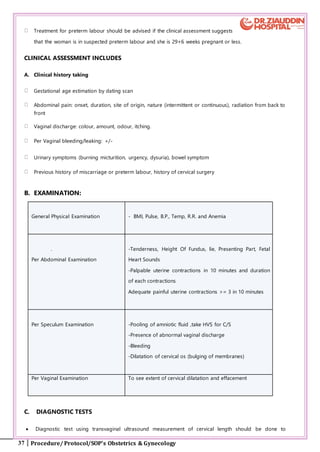




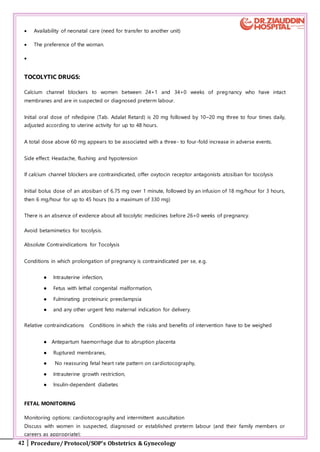
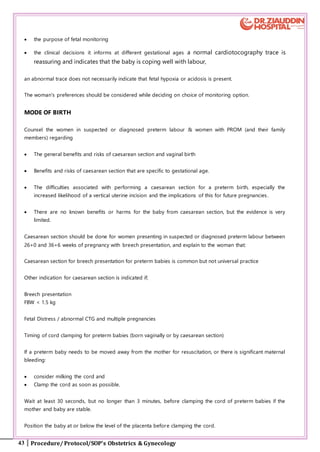
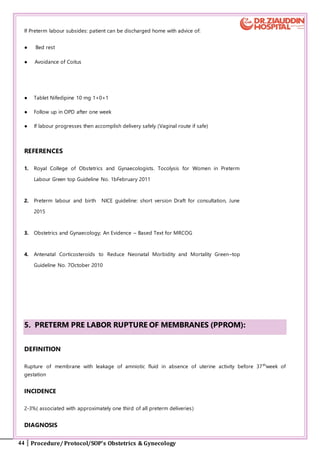






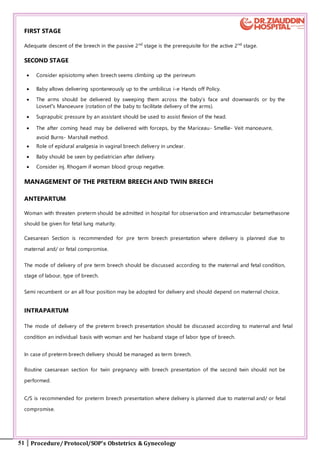


































![86 Procedure/ Protocol/SOP’s Obstetrics & Gynecology
and
- Plasma glucose level of 4-7 mmol/litre before meals at other times of the day.
•
Gestational Diabetes
- A fasting plasma glucose level of 5.6mmol/litre or above
Or
- A 2-hour plasma glucose level of 7.8mmol/litre or above. [New 2015].
TESTING
● Use the 2-hour 75 g oral glucose tolerance test (OGTT) to test for gestational diabetes in women
with risk factors.
● Offer women who have had gestational diabetes in a previous pregnancy:
Early self-monitoring of blood glucose or
● A 75 g 2-hour OGTT as soon as possible after booking (whether in the first or second trimester),
and a further 75 g 2-hour OGTT at 24–28 weeks if the results of the first OGTT are normal.
● Offer women with any of the other risk factors for gestational diabetes: a 75 g 2-hour OGTT at
24–28 weeks.
DIAGNOSIS:
Diagnose gestational diabetes if the woman has either:
A fasting plasma glucose level of 100mg %( 5.6mmol/litre)
A 2-hour plasma glucose level 140mg% or above (7.8mmol/litre)
HISTORY:
Fatigue, Increased thirst, increased urination, Nausea and vomiting Weight loss despite increased appetite.
Frequent vaginal infections, including bladder and skin, blurred vision, family and past history of diabetes
EXAMINATION
Vitals Pulse, B.P., Temp, R.R
P/A HOF, lie, Presenting Part, Fetal Heart Sounds
INTERVENTIONS
Explain to women with gestational diabetes:
Fetal Assessment CTG, U/S pelvis for FWB + Fetal weight](https://image.slidesharecdn.com/protocol-obs-edited-210926125036/85/Protocol-obs-edited-86-320.jpg)


![89 Procedure/ Protocol/SOP’s Obstetrics & Gynecology
Level of risk for the pregnant women with pre-existing diabetes increases with an HbA1c level above 48
mmol/mol (6.5%).
Measure HbA1c levels in all women with gestational diabetes at the time of diagnosis to identify those who
may have pre-existing type 2 diabetes.
Do not use HbA1c levels routinely to assess a woman's blood glucose control in the second and third
trimesters of pregnancy.
Strongly advise women with diabetes whose HBA1c level is above 86mmmol/mol (10%) not to get pregnant
because of associated risk.
MANAGING DIABETES DURING PREGNANCY:
INSULIN TREATMENT AND RISKS OF HYPOGLYCAEMIA
Consider the use of rapid-acting insulin analogues (aspart and lispro) due to their advantages over soluble
human insulin.
The risks of hypoglycemia and impaired awareness of hypoglycemia in pregnancy, particularly in the first
trimester should be told to women with insulin-treated diabetes
Pregnant women with insulin-treated diabetes should also be told to always have available a fast-acting form
of glucose (for example, dextrose tablets or glucose-containing drinks).
Provide glucagon to pregnant women with type 1 diabetes for use if needed & instruct the woman and her
partner or other family members in its use.
If adequate blood glucose control is not obtained by multiple daily injections of insulin without significant
disabling hypoglycemia then offer women the continuous subcutaneous insulin infusion also known as insulin
pump therapy during pregnancy
Consider glibenclamide for women with gestational diabetes in whom blood glucose targets are not achieved
or who cannot tolerate metformin
CONTINUOUS GLUCOSE MONITORING
Continuous glucose monitoring shouldn’t be done routinely to pregnant women with diabetes.
Consider continuous glucose monitoring for pregnant women on insulin therapy:
who have problematic severe hypoglycaemia (with or without impaired awareness of hypoglycaemia) or
who have unstable blood glucose levels (to minimise variability) or
to gain information about variability in blood glucose levels. [new 2015]
Ensure that support is available for pregnant women who are using continuous glucose monitoring from a
member of the joint diabetes and antenatal care team with expertise in its use.](https://image.slidesharecdn.com/protocol-obs-edited-210926125036/85/Protocol-obs-edited-89-320.jpg)







![97 Procedure/ Protocol/SOP’s Obstetrics & Gynecology
Continue to follow the lifestyle advice (including weight control, diet and
exercise) given after the birth
Should have an annual test to check that their blood glucose levels are normal
They have a moderate risk of developing type 2 diabetes.
Tell women with a fasting plasma glucose level between 6.0 and 6.9 mmol/litre that
they are at high risk of developing type 2 diabetes,
Tell women with a fasting plasma glucose level of 7.0 mmol/litre or above that
They are likely to have type 2 diabetes,
Do a diagnostic test to confirm diabetes.
Using HbA1c test as the postnatal test:
Tell women with an HbA1c level below 39 mmol/mol (5.7%) that:
they have a low probability of having diabetes at present
Continue to follow the lifestyle advice (including weight control, diet and exercise) given after the
birth
An annual test to check that their blood glucose levels are normal
they have a moderate risk of developing type 2 diabetes, and offer them advice
Tell women with an HbA1c level between 39 and 47 mmol/mol (5.7% and 6.4%)that
they are at high risk of developing type 2 diabetes,
Tell women with an HbA1c level of 48 mmol/mol (6.5%) or above that
they have type 2 diabetes and refer them for further care.
Tell women who had gestational diabetes & had a negative postnatal test for diabetes
Should have an annual HbA1c test
Tell women who had gestational diabetes
To have early self-monitoring of blood glucose or an OGTT in future pregnancies.
Subsequent OGTT will be done if the first OGTT results in early pregnancy are normal.
The following are safe during pregnancy Regular insulin*, rapid-acting insulin analogues [aspart and lispro*]](https://image.slidesharecdn.com/protocol-obs-edited-210926125036/85/Protocol-obs-edited-97-320.jpg)
![98 Procedure/ Protocol/SOP’s Obstetrics & Gynecology
and / oral hypoglycaemic agents [metformin and glibenclamide]
START INSULIN WHEN
● If AC is > 70th
centile for that gestation (NICE)
● If pt. doesn’t respond to diet / exercise over a period of 2 weeks
● Discuss the effect of hypoglycaemia
INSULIN DOSE REGIMEN
DOSE= 0.7 unit/ kg body wt in first trimester
DOSE= 0.8 unit/ kg body wt in second trimester
DOSE= 0.9 unit/ kg body wt in third trimester
DOSE= 1.0 unit/ kg body wt from 36 weeks of pregnancy
REGIMEN 1
Total calculated dose given in 2 divided doses
Morning dose: (before breakfast)
2/3 NPH + 1/3 regular insulin
Evening dose: (before dinner)
½ NPH + ½ regular Insulin
REGIMEN 2
Regular insulin: (short acting) TDS (pre meals) starting at 4-6 units
If still uncontrolled add:
NPH: (intermediate acting) OD (at bed time) starting at 4-6 units.
99 ml N/S + 1 cc (100 units), regular insulin at 6 micro drops/ min and on opposite side 10% D/W at 100ml/h
REFERENCE
Diabetes in pregnancy: management from preconception to the postnatal period
NICE guideline 2015. Last modified August 2015
Obstetrics and Gynaecology ; An Evidence – Based Text for MRCOG(2nd edition)
2010](https://image.slidesharecdn.com/protocol-obs-edited-210926125036/85/Protocol-obs-edited-98-320.jpg)